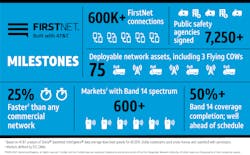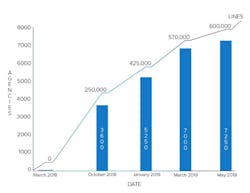If you’re a first responder, there’s a good chance that you’ve already heard of FirstNet. But you may not know why it was established and how it can benefit you—particularly in emergency situations.
Demands for a nationwide public safety network gained broad support after the September 11 terrorist attacks in 2001. The lengthy 9/11 Commission Report advised Congress to expedite an “increased assignment of radio spectrum for public safety purposes,” which eventually resulted in the founding of the First Responder Network Authority, or FirstNet, in 2012. After a lengthy bidding process, AT&T was selected to build out and manage FirstNet, with one important requirement; FirstNet’s network must operate independently from AT&T’s commercial cellular network. So, although FirstNet does share towers, antennas and much of its spectrum with AT&T, it has its own network core, making it more reliable during emergencies when lines can be congested. When it officially launched in March 2018, FirstNet likened itself to “a superhighway that only public safety can use.”
At the time, every state and territory was given the choice to opt into FirstNet or build out its own alternative network. Not surprisingly, all 50 states and six territories elected to join the FirstNet service. What that means is that every public safety officer, law enforcement officer and even volunteer firefighter in the country can enroll in the service, either as part of an entire agency or as an individual.
FirstNet’s dedicated network infrastructure uses Band 14 spectrum in the 700 MHz cellular band, but FirstNet subscribers also have access to all of AT&T’s existing spectrum. In Q1, 2019, AT&T hit a milestone with Band 14 coverage, reaching over 600 US markets, and “running well ahead of schedule,” according to AT&T CEO Randall Stephenson. At the time, the telecom giant had completed 53% of the network’s planned buildout, with 60% within reach by the end of Q3, 2019.
In the 14 months since its launch, FirstNet added 7,250 public safety agencies and more than 600,000 individual lines of service.
But this doesn’t mean that FirstNet is the only option for first responders. Prior to FirstNet, Verizon had the lion’s share of the first responders’ market, and it’s by no means remaining idle. In fact, Verizon launched its competing first responders core network two days after FirstNet, on March 29, 2018. Both networks claim to offer similar standards of ‘priority’ and ‘preemption’ for all public safety communications, meaning that first responders can quickly connect to the network without experiencing dropped calls or data slowdowns. It’s as if first responders are on a special ‘cool kids’ list or have a backstage pass to a VIP-only party.
However, there are differences in the way FirstNet and Verizon operate their networks. Although FirstNet and Verizon both operate dedicated cores for public safety users, prioritization and preemption are managed virtually on Verizon’s network without a separate core. For potential users of these services, however, the differences may be negligible.
The upside
In addition to offering very consistent and reliable calls and data service, there are many reasons why an agency (or an individual) might want to subscribe to a service like FirstNet.
On a practical level, FirstNet’s dedicated bandwidth, priority, and preemption means that it can handle enormous data throughput even in times of crisis when the load on commercial networks skyrockets. Officers can live-stream video from one device to another without buffering or signal failure. More importantly, supervisors, dispatchers, and other resources can access this data in real-time, allowing them to respond quickly with maps, building floorplans and other critical information to assist officers in the field. An officer at one area of an incident will be able to stream video of the scene to another officer in a different place at the same incident, greatly enhancing situational awareness and officer safety.
In addition to the simplification and standardization of communications across agencies, FirstNet provides users with a growing list of approved smartphones and in-vehicle modem devices that work seamlessly with the service. FirstNet also has its own ‘App Store’ where users can download a range of applications specific to the needs of first responders. Examples include NetMotion’s iOS and Android clients for Mobility, a body camera app called 10-21 Video; PulsePoint, which crowdsources CPR-trained individuals; and SceneDoc, a powerful evidence collection, and management tool.
Very little downside
FirstNet’s rollout is ongoing, so it doesn’t yet cover everyone who may require the service. In rural areas where coverage has always been less reliable, AT&T has opened up capacity on its existing LTE bands to augment weak spots. It should also be noted that tools from third-party vendors like NetMotion are available to help first responders maintain call and data connections, even in areas with weak or intermittent signals, and when roaming transitioning Wi-Fi and cellular networks. FirstNet’s mission-critical enhanced location service—based on triangulation using a device’s location—isn’t scheduled to be fully deployed until 2022.
Any public safety agency considering between FirstNet or Verizon really can’t go wrong. The main considerations should be service availability across the region, application options and compatibility with expected use cases. Services like FirstNet undoubtedly help public safety officers stay connected and access the data they need while keeping them and our communities significantly safer. This simply wasn’t possible 20 years ago, so it’s definitely a huge step in the right direction.




